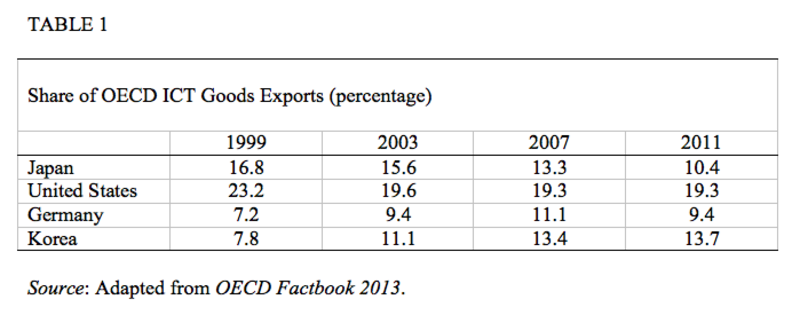Japan has not only suffered from dismal macroeconomic performance over the past two decades, but it has lost its edge in areas of its greatest competitive strength, such as electronics, especially information and communications technology (ICT) hardware.Japanese electronics firms have declined by many standard measures of industrial performance, such as market share, exports, and profits.
Japan’s postwar economic miracle did not quietly fizzle
 |
 |
Steven K. Vogel is Professor of Political Science at the University of California, Berkeley. He specializes in the political economy of the advanced industrialized nations, especially Japan. He is the author of Japan Remodeled: How Government and Industry Are Reforming Japanese Capitalism (Cornell, 2006) and co-editor (with Naazneen Barma) of The Political Economy Reader: Markets as Institutions (Routledge, 2007). His earlier book, Freer Markets, More Rules: Regulatory Reform in Advanced Industrial Countries (Cornell University Press, 1996), won the 1998 Masayoshi Ohira Memorial Prize. He has also edited a volume entitled U.S. – Japan Relations in a Changing World (Brookings Institution Press, 2002).
Related Articles
• Abe, Big
• Jenny Chan, Ngai Pun and Mark Selden, The politics of global production: Apple, Foxconn and China’s new working class
• Andrew DeWit, Japan: Building a Galapagos of Power?
• R. Taggart Murphy, Assessing the Economic Aftershocks of Japan’s March 11 Earthquake
• R. Taggart Murphy, Japan As Number One in the Global Economic Crisis: Lessons for the World
Notes
1 This article is based on Steven K. Vogel, “Japan’s Information Technology Challenge,” in Dan Breznitz and John Zysman, The Third Globalization: Can Wealthy Nations Stay Rich in the Twenty-First Century? (Oxford: Oxford University Press, 2013), 350-72.
2 METI, “Jouhou keizai kakushin senryaku (gaiyou)” [Information Economy Renovation Strategy (Summary)] (May 2010), 3; METI, “Sangyou kouzou,” 22.
3 METI, “Jouhou keizai,” 4.
4 Breznitz and Zysman, The Third Globalization, 4-12.
5 METI, “Sangyou kouzou bijon gaiyou” [Industrial Structure Vision Outline] (June 2010), 24.
6 Abraham Newman and John Zysman, “Transforming Politics in the Digital Era,” in Zysman and Newman, eds., How Revolutionary Was the Digital Revolution? National Responses, Market Transitions, and Global Technology (Stanford: Stanford Business Books, 2006), 391-411.
7 Michael G. Borrus, Competing for Control: America’s Stake in Microelectronics (Cambridge, MA: Ballinger, 1988).
8 Robert E. Cole and D. Hugh Whittaker, “Introduction,” in Whittaker and Cole, eds., Recovering From Success: Innovation and Technology Management in Japan (Oxford: Oxford University Press, 2006), 8-14.
9 METI, “Jouhou keizai,” 8.
10 Richard Katz, Japan The System That Soured: The Rise and Fall of the Japanese Economic Miracle (Armonk, NY: M.E. Sharpe, 1998), 29-46
11 Robert E. Cole, “Software’s Hidden Challenges,” in Whittaker and Cole, eds., Recovering From Success: Innovation and Technology Management in Japan (Oxford: Oxford University Press, 2006), 105-26; Robert E. Cole and Shinya Fushimi, “The Japanese Enterprise Software Industry: An Evolutionary and Comparative Perspective,” in Hiroaki Miyoshi and Yoshifumi Nakata, eds., Have Japanese Firms Changed? The Lost Decade (Houndmills, Basingstoke, Hampshire, UK: Palgrave MacMillan, 2011), 41-69
12 Ashish Arora, Lee G. Branstetter, and Matej Drev, “Going Soft: How the Rise of Software-Based Innovation Led to the Decline of Japan’s IT Industry and the Resurgence of Silicon Valley,” National Bureau of Economic Research Working Paper 16156 (July 2010).
13 Kenji E. Kushida, “Leading Without Followers: How Politics and Market Dynamics Trapped Innovations in Japan’s Domestic ‘Galapagos’ Telecommunications Sector,” Journal of Industry, Competition, and Trade (2011) 11: 279-307.
14 Steven K. Vogel and John Zysman, “Technology,” in Vogel, ed., U.S.-Japan Relations in a Changing World (Washington D.C.: Brookings Institution Press, 2002), 252.
15 Vogel, Japan Remodeled, 44-45, 51-61.
16 “Nihon saikou senryaku – Japan is Back” [Japan Revitalization Strategy], June 14, 2013.



